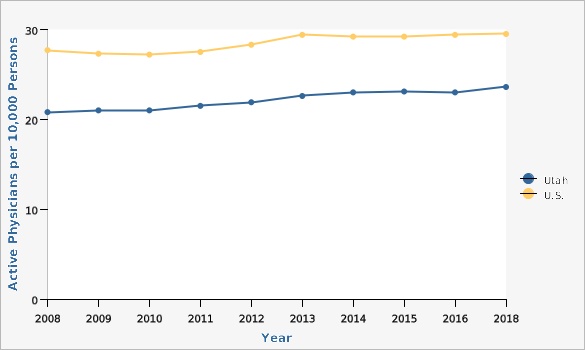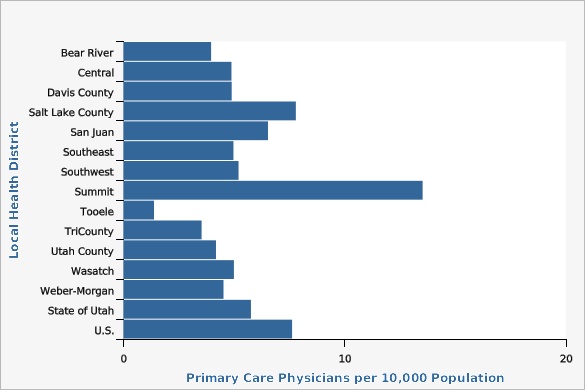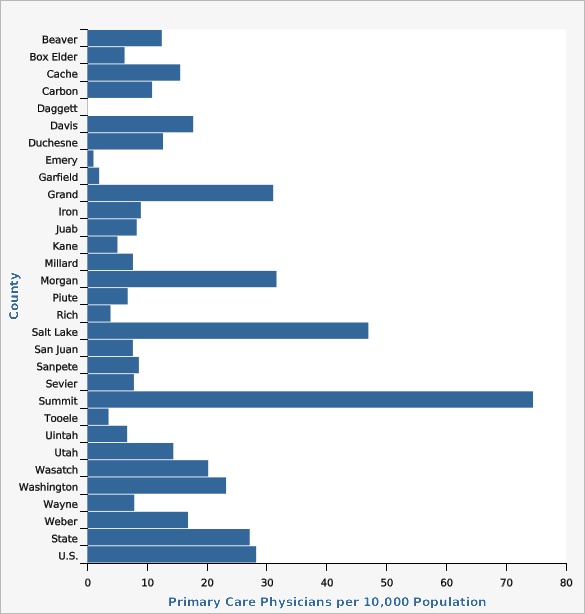Complete Health Indicator Report of Physician Supply
Definition
This Indicator Report includes two measures of physician supply: [[br]] 1) Active physicians per 10,000 civilian population.[[br]] 2) Primary care physicians per 10,000 civilian population.Numerator
1) Number of active physicians.[[br]] 2) Number of primary care physicians.Denominator
Civilian population.Data Interpretation Issues
This indicator includes two measures of physician supply: 1) 'Active Physicians' are defined as those physicians currently engaged in patient care or other professional activity for a minimum of 20 hours per week. Other professional activity includes administration, medical teaching, research, and more. This measure has been reported by the Secretary of the Department of Health and Human Services to the President and the Congress of the United Stated in the annual report, the most recent of which is 'Health, United States 2017'. Data are based on reporting by physicians. 2) 'Primary Care Physicians' include non-federal M.D.s and D.O.s under age 75 who are not hospital residents and whose major professional activity is patient care in General Practice; General Family Medicine; General Internal Medicine; or General Pediatrics. This information comes from the Health Resources and Services Administration, Area Health Resource File (AHRF) that utilizes the American Medical Association Physician Masterfiles.Why Is This Important?
The ratio of physicians to persons in a population is an indication of the adequacy of the health system and the access to care for persons in that population.Healthy People Objective AHS-4.1:
(Developmental) Increase the number of practicing medical doctorsU.S. Target: Developmental
How Are We Doing?
In 2018, the ratio of primary care physicians to population varied between the 13 local health districts (LHDs) in Utah from 12.9 per 10,000 in Summit County Health District to 1.7 in Tooele County Health District. This ratio varied among the 29 counties in Utah from 13.3 per 10,000 people in Grand County to 0 in Daggett, Piute, and Rich Counties. It must be kept in mind that primary care physicians are classified by county, but physicians who practice in multiple locations may see patients who reside in surrounding counties.How Do We Compare With the U.S.?
The ratio of active physicians to persons in the Utah population has been lower than the U.S. ratio for all years reported. In 2018, there were 29.5 active physicians per 10,000 population in the U.S. compared to 23.6 per 10,000 in Utah. In 2017, the ratio of primary care physicians to population was also lower in Utah (5.8 per 10,000) when compared to the U.S. (7.6 per 10,000).What Is Being Done?
The Utah Department of Health, Office of Primary Care and Rural Health (OPCRH) administers multiple programs to assist in the recruitment and retention of physicians to rural and underserved communities in Utah. Two state-funded programs, the Rural Physician Loan Repayment Program and the Health Care Workforce Financial Assistance Program offer student loan repayment to physicians, dentists, and mid-level providers in exchange for working in underserved areas. The National Health Service Corps (NHSC) also administers loan repayment and scholarship programs to healthcare providers who work in rural and/or federally designated Health Professional Shortage Areas (HPSAs). The Primary Care Office (PCO), within the OPCRH, evaluates the health professional shortages in the state and submits applications to receive a federal HPSA designation. The PCO also coordinates the NHSC programs for the state. The OPCRH coordinates the Conrad 30 J-1 Visa Waiver program which recruits foreign-trained physicians to practice in underserved communities in the state. The OPCRH also supports 3RNet, a job board for healthcare providers to be matched with rural and underserved facilities that are actively recruiting providers. Additionally, the OPCRH has convened a Utah Health Workforce Coalition to help address the shortages of all healthcare providers across Utah.Available Services
Office of Primary Care and Rural Health[[br]] Bureau of Emergency Medical Services and Preparedness[[br]] Division of Family Health and Preparedness[[br]] Utah Department of Health[[br]] P.O. Box 142005[[br]] Salt Lake City, UT 84114-2005[[br]] (801) 273-6621[[br]] FAX: (801) 273-4146[[br]] Web: [http://ruralhealth.health.utah.gov]Related Indicators
Relevant Population Characteristics
The need for medical services is dependent on the age of the population. The fact that the Utah population is growing older and people are living longer will affect the need for health care services as people live longer and with one or more chronic conditions.Related Relevant Population Characteristics Indicators:
Health Care System Factors
The Utah Health Care Work Force Financial Assistance Program has successfully assisted in retaining health care professionals serving rural and under-served populations in Utah through providing educational loan repayment.Related Health Care System Factors Indicators:
Health Status Outcomes
People who are unable to obtain timely primary medical care, especially if they have an existing chronic health condition, may require hospital care that could have been avoided.Graphical Data Views
Active Physicians per 10,000 Civilian Population, Utah and U.S., 2008-2018

The ratio of active physicians to persons in the Utah population has been lower than the U.S. ratio for all years reported.
| Utah vs. U.S. | Year | Active Physicians per 10,000 Persons | ||||
|---|---|---|---|---|---|---|
Record Count: 20 | ||||||
| Utah | 2008 | 20.8 | ||||
| Utah | 2009 | 21.0 | ||||
| Utah | 2010 | 21.0 | ||||
| Utah | 2011 | 21.5 | ||||
| Utah | 2012 | 21.9 | ||||
| Utah | 2013 | 22.6 | ||||
| Utah | 2014 | 23.0 | ||||
| Utah | 2015 | 23.1 | ||||
| Utah | 2016 | 23.0 | ||||
| Utah | 2018 | 23.6 | ||||
| U.S. | 2008 | 27.7 | ||||
| U.S. | 2009 | 27.3 | ||||
| U.S. | 2010 | 27.2 | ||||
| U.S. | 2011 | 27.5 | ||||
| U.S. | 2012 | 28.3 | ||||
| U.S. | 2013 | 29.4 | ||||
| U.S. | 2014 | 29.2 | ||||
| U.S. | 2015 | 29.2 | ||||
| U.S. | 2016 | 29.4 | ||||
| U.S. | 2018 | 29.5 | ||||
Data Notes
Includes active doctors of medicine (MDs) and active doctors of osteopathy (DOs). Starting with 2003 data, federal and non-federal physicians are included. Data prior to 2003 included non-federal physicians only. Active (or professionally active) physicians are defined as those currently engaged in patient care or other professional activity for a minimum of 20 hours per week. Other professional activity includes administration, medical teaching, research, and more. Data from National Center for Health Statistics. Health, United States, 2017.Data Sources
- U.S. Department of Health and Human Services, Centers for Disease Control and Prevention (CDC)
- National Center for Health Statistics
Primary Care Physicians per 10,000 Population by Local Health District, Utah and U.S., 2019

| Local Health District | Primary Care Physicians per 10,000 Population | |||||
|---|---|---|---|---|---|---|
Record Count: 15 | ||||||
| Bear River | 4.0 | |||||
| Central | 4.9 | |||||
| Davis County | 4.9 | |||||
| Salt Lake County | 7.8 | |||||
| San Juan | 6.5 | |||||
| Southeast | 5.0 | |||||
| Southwest | 5.2 | |||||
| Summit | 13.5 | |||||
| Tooele | 1.4 | |||||
| TriCounty | 3.5 | |||||
| Utah County | 4.2 | |||||
| Wasatch | 5.0 | |||||
| Weber-Morgan | 4.5 | |||||
| State of Utah | 5.8 | |||||
| U.S. | 7.6 | |||||
Data Notes
Primary care physicians include non-federal M.D.s and D.O.s under age 75 who are not hospital residents and whose major professional activity is patient care in General Practice; General Family Medicine; General Internal Medicine; or General Pediatrics.Data Source
Area Health Resource File (AHRF), U.S. Department of Health and Human Services, Health Resources and Services AdministrationPrimary Care Physicians per 10,000 Population by County, Utah and U.S., 2019

| County | Primary Care Physicians per 10,000 Population | |||||
|---|---|---|---|---|---|---|
Record Count: 31 | ||||||
| Beaver | 8.9 | |||||
| Box Elder | 3.0 | |||||
| Cache | 4.4 | |||||
| Carbon | 3.4 | |||||
| Daggett | 0.0 | |||||
| Davis | 4.9 | |||||
| Duchesne | 4.5 | |||||
| Emery | 1.0 | |||||
| Garfield | 4.0 | |||||
| Grand | 12.3 | |||||
| Iron | 3.8 | |||||
| Juab | 6.7 | |||||
| Kane | 3.8 | |||||
| Millard | 4.6 | |||||
| Morgan | 9.1 | |||||
| Piute | 0.0 | |||||
| Rich | 0.0 | |||||
| Salt Lake | 7.8 | |||||
| San Juan | 6.5 | |||||
| Sanpete | 4.8 | |||||
| Sevier | 4.6 | |||||
| Summit | 13.5 | |||||
| Tooele | 1.4 | |||||
| Uintah | 3.1 | |||||
| Utah | 4.2 | |||||
| Wasatch | 5.0 | |||||
| Washington | 5.6 | |||||
| Wayne | 3.7 | |||||
| Weber | 4.3 | |||||
| State | 5.8 | |||||
| U.S. | 7.6 | |||||
Data Notes
Primary care physicians include non-federal M.D.s and D.O.s under age 75 who are not hospital residents and whose major professional activity is patient care in General Practice; General Family Medicine; General Internal Medicine; or General Pediatrics.Data Source
Area Health Resource File (AHRF), U.S. Department of Health and Human Services, Health Resources and Services AdministrationReferences and Community Resources
Health, United States: 2017, [https://www.cdc.gov/nchs/data/hus/hus17.pdf] Area Health Resource Files[[br]] [https://data.hrsa.gov/data/download]More Resources and Links
Evidence-based community health improvement ideas and interventions may be found at the following sites:- Centers for Disease Control and Prevention (CDC) WONDER Database, a system for disseminating public health data and information.
- United States Census Bureau data dashboard.
- Utah healthy Places Index, evidence-based and peer-reviewed tool, supports efforts to prioritize equitable community investments, develop critical programs and policies across the state, and much more.
- County Health Rankings
- Kaiser Family Foundation's StateHealthFacts.org
- Medical literature can be queried at PubMed library.
Page Content Updated On 12/03/2021,
Published on 12/03/2021
